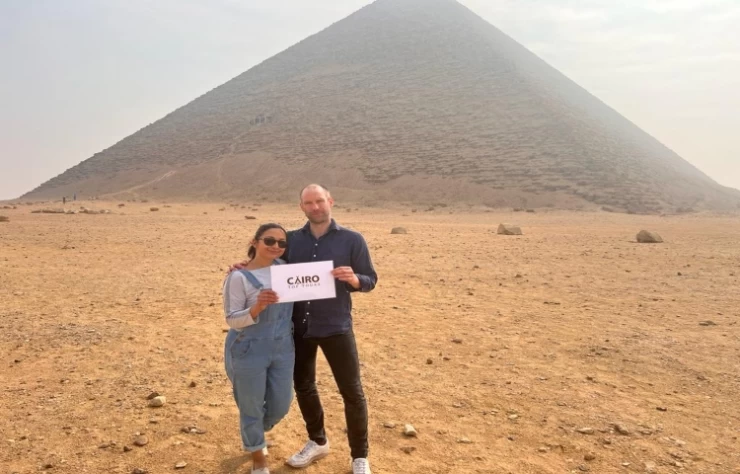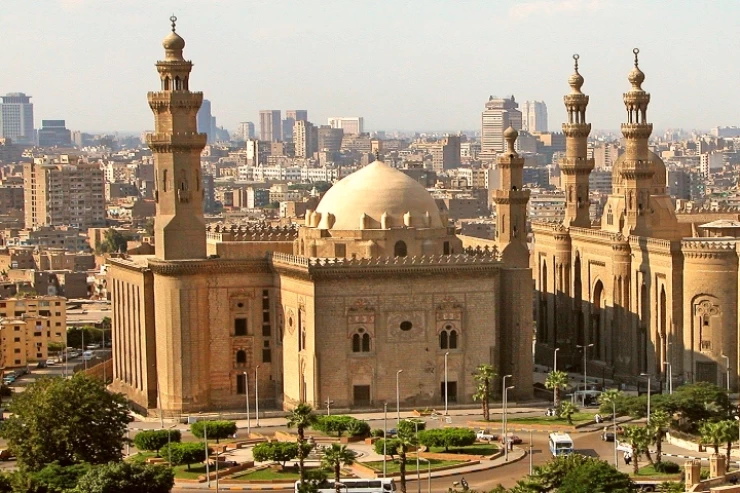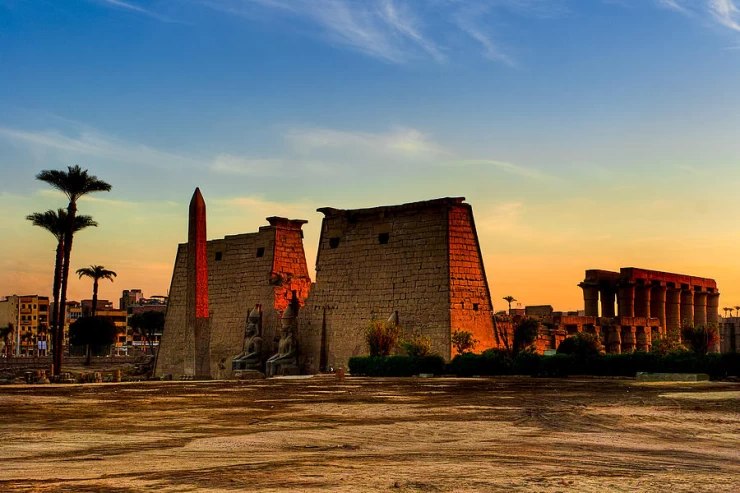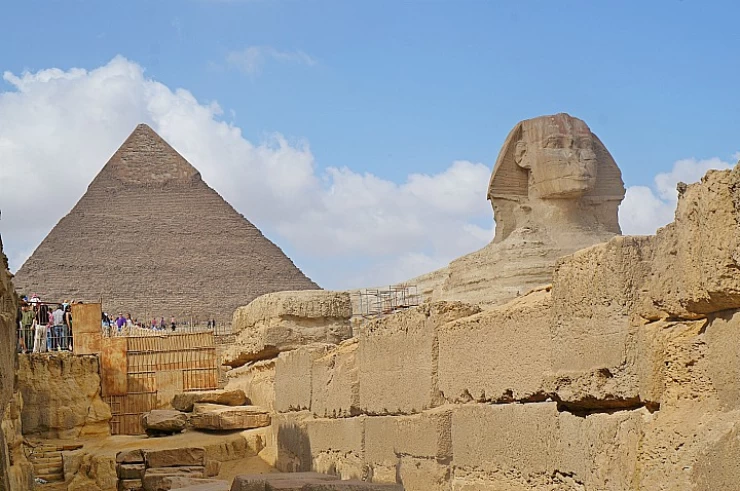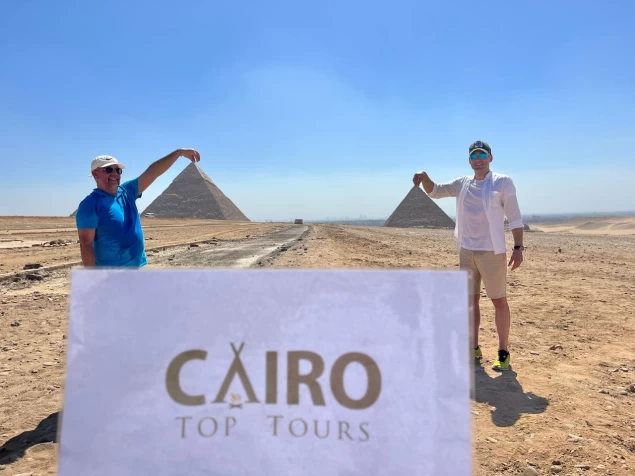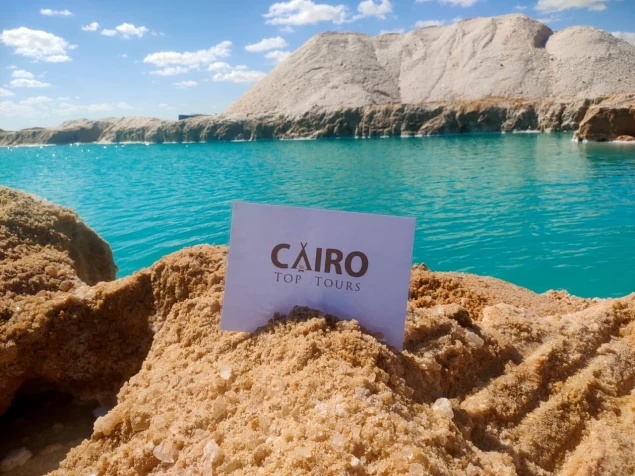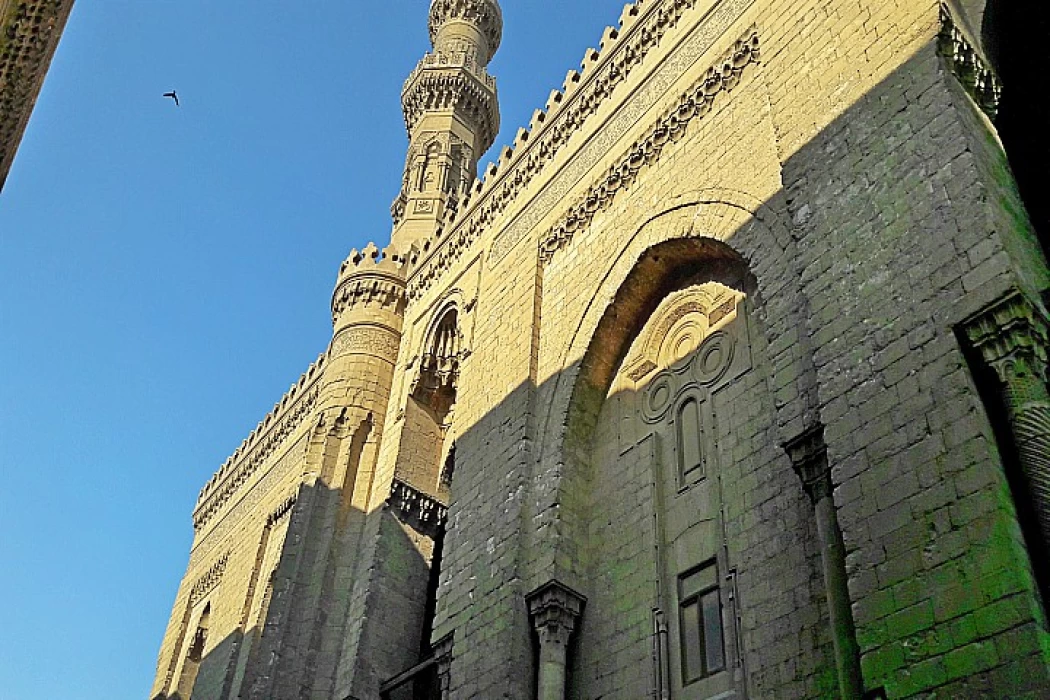
History of Al Rifai Mosque
In the year 1298 Ah/1880 ad, the architecture of the mosque was stopped, then Khushyar Hanem died in 1303 Ah/1885 ad, and the construction project remained stalled for about 25 years. he completed it in 1329 Ah/1911 ad, and the mosque was opened for prayer on the eve of the month of Muharram in 1330 Ah/1912 ad.
Naming
At the end of the model of the mosque in the eastern tribal area, it was written: "this honorable mosque, the mosque of Al-Arif, by Allah Almighty, Mr. Ahmed al-Rifai, may Allah be pleased with him, has been carefully completed, according to the order of the supreme guardian of blessings, the Supreme Khedive of Egypt, the most great hajj Abbas Helmy II, God dearest his state and his highest word, in the twenty-eight and three hundred and Thousand Year of the emigration of those who are to the prophets and messengers, concluding on him and his family and companions, complete prayer and peace".
Although the name of the mosque is attributed to Sheikh Ahmed bin Ali al-Rifai, his grave is not there, as his death was in the village of Umm ubayda in Iraq in 578 AH/1182 AD.
Sheikh Ahmed al-Rifai
Sheikh Ahmed al-Rifai was born an orphan on Umm ubayda island in Iraq in 512 Ah, he was sponsored by his uncle Sheikh Mansour al-bataihi, and is attributed to his seventh grandfather Rifaa, who emigrated to Morocco to escape the persecution of the Abbasids for the Alawites in the Levant, so he settled in Seville, married and had a large number of children, and his grandson Yahya traveled to the Hijaz to perform the hajj, so he stayed in Mecca for a short period, and then and Ahmed al-Rifai. Ahmad received religious sciences and memorized the Koran at a young age and frequented leading scholars such as Sheikh Mansour al-Bataihi, Sheikh Ali al-Wasti, and Imam Kharnoubi. At the age of twenty-five, his uncle Sheikh Mansour al-Bataihi died after the succession of his way. The Sheikh left a lot of papers and books on various religious sciences in monotheism, Tafsir, Hadith, Sufism, and jurisprudence, and died in the village of Umm Ubayda and was buried in his mausoleum there in 572 AH or 578 AH.
The construction of the mosque was ordered by Khushiyar Hanem or Hoshyar Khater Hanem or Hoshyar Kadin, a Turkish-born lady who was one of the wives of Ibrahim Pasha. the sister of Sultana "bertonal", the wife of the Ottoman Sultan Mahmud II, the mother of Sultan Abdul Aziz I. Khushiyar hanem lived in the AL-dubara Palace in the Garden City area, and died in 1303 Ah/1885 ad at the age of more than seventy years and was buried in the al-Rifai mosque.
Max Hertz Pasha
He studied in the offices of Egypt and entered the sawari school there, then he was chosen to travel to France on an expedition in 1844 to enroll in the Egyptian military school in Paris, then he entered the Civil Corps Department and graduated from it and joined the higher engineering school in Paris. After completing his studies, he returned to Egypt during the reign of Abbas I at the age of 22, and the Wali bestowed on him the rank of Amir Alai. Hertz Pasha was a Hungarian engineer who was born in one of the territories of Hungary that now belongs to Romania in 1856. He lived in Egypt from 1880 to 1914, joined the Technical Office of the Egyptian Ministry of Awqaf in 1881, and in 1890 became the engineer responsible for the maintenance of Islamic monuments and Coptic architecture in Egypt.
Sheikh Ali Abu Shabak al-Rifai bin Ahmed bin Abdul Rahim bin Othman al-Rifai brother of the Sufi pole Ahmed al-Rifai bin Ali al-Makki bin Yahya Al-Naqib Basra bin Thabit bin Al-Hazem Ahmed Ali al-Makki bin Al-Hassan Rafaa bin al-Mahdi Bin Abu Al-Qasim bin Mohammed Al-Hazen bin al-Hussein bin al-Hussein bin Ahmed al-Akbar bin Musa Abu Shiha bin Ibrahim al-Murtada bin Musa al-Kadhim bin Jafar Al-Sadiq bin Mohammed al-Baqer bin Ali Zain al-Abidin bin Hussein bin Ali bin Abi Talib, where his father Ahmed Al-Sayyad 683 and took the Sufi way of his grandfather and called her and made a residence His family is in the arms market, the headquarters of the Levant roads.
History
this ancient site was occupied by part of the land of the ammunition mosque, which was located towards the windows of the Sultan Hassan School, which was established by the ammunition of King Jafar, the head of the police and the governor of Cairo and its owner in 516 Ah/1122 ad. the site also had a corner known. In the year 1286 Ah/1869 ad, khushiyar hanem, the mother of Khedive Ismail, ordered the renovation of the Rifai corner, so I bought the places adjacent to it and ordered its demolition and entrusted Hussein Pasha Fahmy, the undersecretary of the Diwan of endowments, to prepare a project to build a large mosque with burials for her family and there were modifications proposed by engineer Jay, which were not accepted, and then other modifications were offered to eliminate errors in the construction, discussed by Hussein Pasha Fahmi Al-Maamar, and began to be implemented after his death.
In the year 1298 Ah/1880 ad, the architecture of the mosque was stopped, and then khushyar hanem died in 1303 Ah/1885 ad, and the work remained suspended for about 25 years until 1905, when the Khedive Abbas Helmy II entrusted Ahmed Khairy Pasha, the director of private endowments, to complete the mosque, and in turn assigned the engineer Herts Pasha bashm, the engineer of Arab antiquities, to prepare and complete the mosque repair project, Herts Pasha and his Italian assistant Carlo Virgilio silvini prepared the project he received approval and was ordered on July 12, 1906 to start work.
During the completion of construction works and making adjustments, Hertz Pasha was careful not to change much in Hussein Pasha's architectural project, so he began to strengthen the walls and change the damaged buildings and contracts, and used the materials that had been deposited in the warehouses of the mosque on behalf of its architecture since 1880, he used imported gold from Istanbul, carpentry materials, and some writings prepared by the calligrapher Abdullah Bey Zahdi, and he supplemented the missing and changed the damaged writings of the calligrapher of the royal palace Sheikh Mustafa Hariri, and also used in the workshops of Harka in Turkey, glass niches made in the style of the niches of the ancient mosques of Egypt in the Fourteenth and fifteenth centuries AD, including about 240 niches Painted with enamel made in Bohemia and decorated with Quranic and historical writings. The cost of construction until 1880 amounted to 500,000 pounds, which was increased during the completion of construction works by 132,500 pounds, and some other expenses were added to it. At the end of the year 1329 Ah/1911 ad, the mosque was completed, and it was opened for prayer on Friday on the eve of the month of Muharram in 1330 Ah/1912 ad.
The design
The architects of the Rifai mosque, when developing its design, tried to keep up with the Sultan Hassan mosque next to it in grandeur and height, although they met some difficulties criticized by archaeologists, which was remedied by Hertz Pasha to make the mosque when completed one of the finest mosques established in the twentieth century, the most decorative and Mastered by industry. The area of the mosque inside is 6,500 meters, the part dedicated to prayer is 1,767 meters, and the rest of the area was allocated for burials and accessories. The mosque has two minarets erected on Round bases, like the minarets of the Sultan Hassan mosque, as for the entrances, they are towering and shrouded in stone.
The western side is centered on the royal entrance, which is surrounded by stone columns with decorative marble bases, and to the right of the interior of this door is the Tomb of King Fuad I in the western corner of the mosque, which is covered with colored marble, and is adjacent to the Tomb of his mother, Princess Ferial. On the sides and in the center of the mosque, niches were erected with decorative marble columns and gilded crowns, the marble needed for them was brought from Beni Suef, Turkey, Greece, Italy, Germany and Belgium.on the side of the mihrab is a large pulpit with fillings of tooth, Ebony and walnut wood, and his helmet and Muqarnas were carved with gold.
As for the seaward side, it has six doors, of which four connect to the tombs and two connect to two spaces between those tombs. There are four graves in the eastern chamber, all of them for the sons and daughters of Khedive Ismail, one of which is for the late Ali Jamal al-Din, the second for Mrs. tawhida hanem, the third for Mrs. Zeinab hanem, and the fourth for the late Ibrahim Helmy, and this chamber is topped by a dome decorated with colored Muqarnas, and to the left of this dome from the western side is one of the two.
Theft of contents
As it turned out that an accessories supply official was behind the incident, he took advantage of filming some scenes of one of the films at the Rifai mosque, removed the archaeological complaints and hid them inside his car to sell them in agreement with his partners for an amount of 900 thousand pounds.
Currently
Rifai mosque is on the face of the current design of an Egyptian ten-pound coin in circulation, and Rifai mosque is on the face of an ancient design of an Egyptian ten-pound coin in circulation.
Honours
In recognition of the Egyptian state's pride in the archaeological and cultural value of the mosque, and recognizing that it is one of its most important tourist attractions, and as a kind of highlight to show its antiquity and originality, the face of the Egyptian ten-pound banknote was decorated with the image of the Rifai mosque in more than one issue, and the back of the current paper bears the image of King Khafre.
It was inbuilt in 2 totally different periods, that is between 1869 and 1912, thus it's characterized by totally different inventive and subject designs. Next to that stands the far better well-known ruler Sultan Hassan Mosque, chemical analysis back to the ordinal century, that has remained intact despite the troubled centuries of history.

The prodigious size of the house of worship is most hanging. it's counted jointly of the main things to do in Cairo and is located in Midan El Qala’a, right below the Citadel of Salah El -Din in the foremost central part of Islamic Cairo. you'll be able to reach the house of worship of Al Rifa’i through a mutual entrance shared by the 2 mosques this one and therefore the mosque of Sultan Hassan.

Many renowned folks are buried here in Al Rifai house of worship, tons of them belong to soldier family-like Kushyar Hanim ordered its construction in 1869, and her son the renowned Khedive Ismail, United Nations agency refurbished Cairo and most of Egypt likewise as Sudan that wont to be a part of the Egyptian kingdom. The house of worship hosted the deceased body of Muhammad Reza Pahlavi crowned head Pahlavi, known for being the ultimate of Iran before the Moslem Revolution, that caused the Ruholla Khomeini rule.
within the same burial space lies the Shah’s son, Mohamed Reza Pahlavi died in 1980 whereas in exile in Cairo. Another notable figure buried here was Yehya Al Ansari, a guide of the Prophet Mohamed ( peace be upon him) and native saint Ali Abu-Shubbak. though not technically buried within the house of worship Arab chief Ali Al Rifai, the United Nations agency was a number one figure in Islamic Cairo throughout medieval times, including a shrine wherever several locals return till at the present time to hope and receive a number of his blessings.
Before the large reconstruction, Al Rifai house of worship was situated at the positioning of a little house of worship named Rifai Zawiya and was believed to create several of the known scholar followers and students, you'll be able to visit the house of worship throughout any of the regular Cairo Day Tours
Perhaps you may value more highly walking to the house of worship from the castle of salaah El-Din Street, and there's a motivating read of the traditional Egyptian homes awaiting appreciation. you'll be able to conjointly get near to the house of worship via Sayeda Aisha Street, which is able to conjointly lead you to the most gate. it's a double gate shared by each Al-Rifai and ruler Hassan, you may pass it through the protection scanner or detector. the 2 mosques are separated by a comparatively slender pedestrian street, and therefore the huge structure of the Al-Rifai house of worship mustn't be stunning if its size and talent to contend with the neighboring ruler Hassan house of worship, had been of utmost importance.
When you walk shortly towards the entrance of the Al Rifai house of worship, a high step takes you to a large portal. As a sort of respect and to avoid confusion, guests to the house of worship should be able to take away their shoes before they enter, and therefore the girls are kindly requested to wear incommunicative garments and that they will bring on a headband.
The house of worship includes a nice similarity to several of the fashionable structures. Once within, one will solely notice the attractive ceiling. Gold was especially foreign from Turkey for coating. guests ought to be happy to wander around within this subject marvel. we advise you to visit the burial places of Khedive Ismail and Reza crowned head Pahlavi.
Once you're finished viewing of these Islamic patterns, be happy to run your hands across the shrine of Al Rifai marked by inexperienced lights within the space right within the middle of the house of worship. you'll be able to even scan your prayers or create a would like that may be certainly fulfilled! If you're visiting the mosque on a Friday morning it'll be most of the time quiet and empty.







